2. 安徽科技学院 建筑学院,安徽 蚌埠 233000;
3. 蚌埠市特种设备监督检验中心,安徽 蚌埠 233000
2. School of Architecture, Anhui University of Science and Technology, Bengbu 233000, China;
3. Bengbu Special Equipment Supervision and Inspection Center, Bengbu 233000, China
低合金结构钢因其优异的力学性能被广泛应用于特种设备、机械与建筑钢结构等工程领域。然而,日益复杂的火灾风险,使特种设备用钢及其钢结构面临的高温劣化风险指数不断提高。高温劣化后钢虽能够保留形状,但高温劣化对其性能影响深远,且基于火灾形成的高温劣化方式复杂多变,使得其对钢的性能影响错综复杂[1-3]。
近年来,高温服役后结构钢力学性能变化研究引起了学者们的关注,如低合金钢[4]、高强钢[5-6]、超高强度钢[7-8]、冷弯成形钢[9-11]等。Jiang等[5]研究了温度和焊接热输入效应对建筑工程用Q690CFD钢的力学性能的影响规律,提出了可用于TMCP高强钢火灾及火灾后力学性能评价的预测方程。Fatemeh等[7]通过研究1200级超高强度钢管在300~800 ℃范围内的力学性能,提出了温度与应力-应变的关系模型。Singh等[9]研究了温度对YSt-310冷弯方钢管和矩形钢管抗拉性能与硬度的影响,建立了受火温度与硬度值之间的变化规律。Zhou等[12]通过研究桥梁和海上平台用Q620高速钢3种冷却方式(自然冷却、泡沫冷却和浸水冷却)下的高温力学性能,提出了一种预测Q620高速钢灾后力学性能的分段函数模型。Shi等[13]研究了火灾温度对建筑结构用Q345钢焊后力学性能的影响,发现焊后试样经800 ℃水冷后其性能远低于母材,并提出火灾后焊缝力学性能预测公式。Dan等[14]研究了690 MPa级以下的建筑用结构钢在20~800 ℃高温空冷后的力学性能,发现各结构钢的力学性能在超过600 ℃时开始降低,研究人员通过采用非线性拟合的方法,建立了各结构钢火灾温度与应力-应变的关系模型。综上可知,上述研究主要围绕不同冷却方式、成型工艺等因素对建筑用钢高温冷却后力学性能的影响,但针对特种设备用钢遭受火后力学性能的影响机制的研究,尚鲜有文献报道,尤其是劣化温度与强度变化因子之间的关系方面。鉴于建筑结构用钢和特种设备用钢的抗火要求与性能要求不同,导致前述研究结果并不能用于特种设备用钢。因此,为了保障特种设备用钢高温劣化后的服役安全性能,开展特种设备用钢高温劣化后力学性能变化规律的研究迫在眉睫。
为揭示高温劣化方式对特种设备用钢力学性能的影响规律,本文以特种设备常用钢Q345为研究对象,对其高温劣化后的抗拉性能进行研究。首先,通过单轴拉伸实验获取不同高温劣化方式后的应力-应变关系曲线;其次,对高温劣化后材料的抗拉性能进行统计分析,以揭示高温劣化方式对材料弹性模量和强度的影响规律;再次,通过SEM获取材料的微观断口特征形貌数据,分析高温劣化方式对失效形式的影响作用;最后,采用非线性统计方法,揭示高温劣化方式与强度之间的相互关系,构建材料强度和劣化温度之间的关系模型,以期为高温劣化后特种设备用钢的服役安全性能评价提供理论指导。
1 实验 1.1 材料与试样本文以4 mm厚的特种设备用热轧Q345B钢为研究对象,其化学成分如表 1所示,该材料采用氧气转炉冶炼和连铸热轧工艺。采用线切割沿板材轧制方向进行取样,试样为标准板状拉伸试样,试样尺寸见图 1。
| 表 1 Q345B钢的化学成分(质量分数/%) Table 1 Chemical compositions of Q345B steel (wt. %) |
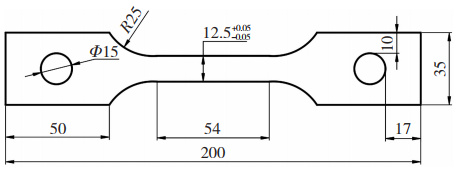
|
图 1 拉伸试样尺寸图:(单位:mm) Fig.1 Dimensions of tensile sample |
为揭示高温劣化方式对Q345B钢宏观力学性能的影响规律,采用高温空冷和高温水冷两种劣化方式对材料进行劣化处理,具体劣化过程为:首先将试样放入XL-1200高温箱式淬火加热炉中,以10 ℃/min的升温速率将试样由室温(20 ℃)加温至劣化温度T(300、500、700、900和1 000 ℃)并保温20 min,然后采用空冷(Cooling in air, CIA)和水冷(Cooling in water, CIW)两种方式将试件冷却至室温,如图 2所示。为了明确两种高温劣化过程中试样的温度变化情况,采用热电偶对劣化过程中试件表面的温度变化进行跟踪测量,结果如图 3所示。
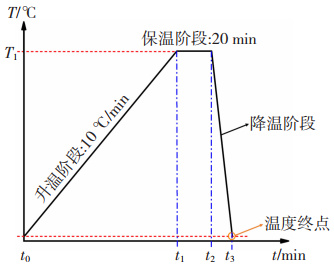
|
图 2 Q345B钢高温劣化过程示意图 Fig.2 Schematic diagram of high temperature degradation process of Q345B steel |
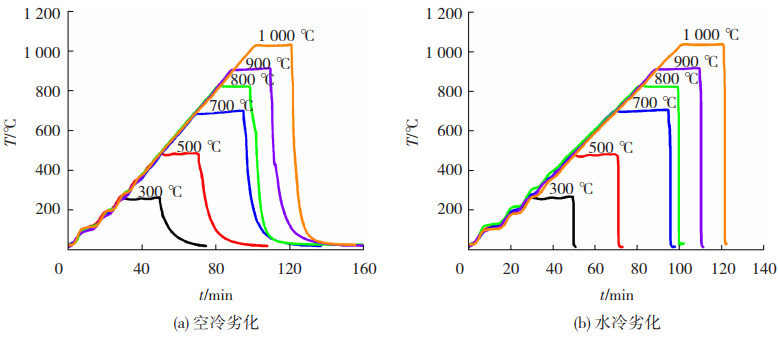
|
图 3 高温劣化的温度-时间曲线 Fig.3 Temperature-time curve of high temperature deterioration: (a) air cooling deterioration; (b)water cooling deterioration |
根据两种高温劣化方式,将拉伸试样分为13组,如表 2所示。采用三思UTM5105电子万能试验机进行拉伸实验,拉伸速度为3 mm/min。为了保证测试结果的准确性,每组至少测试3个试件,以300 ℃为例,两种劣化条件下的应力(σ)-应变(ε)关系曲线如图 4所示。
| 表 2 试样分组(件) Table 2 Sample grouping (PCS) |
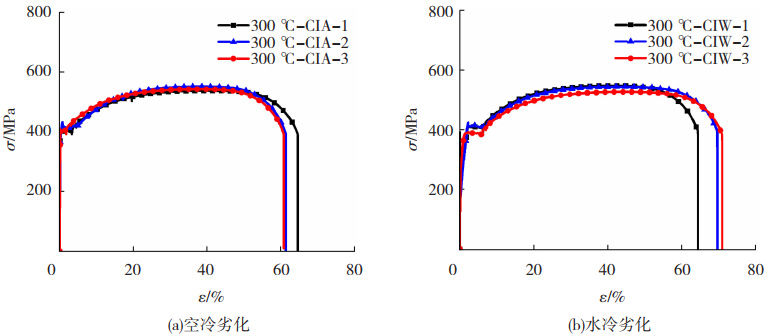
|
图 4 300 ℃劣化处理下Q345B钢的应力-应变曲线 Fig.4 Stress-strain curve of Q345B steel under 300 ℃ deterioration treatment: (a)air cooling deterioration; (b) water cooling deterioration |
鉴于劣化温度对材料的宏观力学性能和断口形貌均有很大影响,分别对两种劣化方式处理后的Q345B钢各温度的微观组织进行观测,结果如图 5所示,其中, 图 5(a)为Q345B钢原始显微组织(20 ℃),图 5(b)~(g)为空冷劣化时材料的微观组织形貌,图 5(h)~(m)为水冷劣化时材料的微观组织形貌。
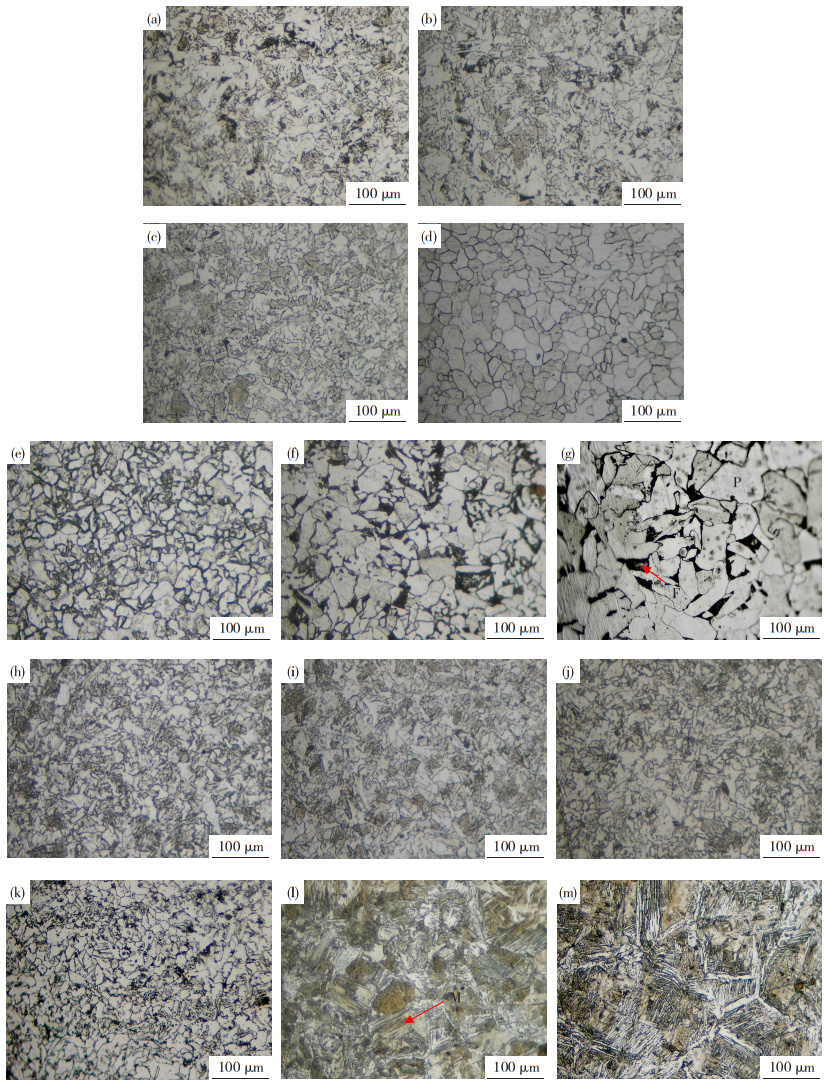
|
图 5 高温劣化处理后Q345B钢微观组织形貌 Fig.5 Microstructure of Q345B steel after high temperature deterioration treatment: (a) 20 ℃; (b) CIA-300 ℃; (c) CIA-500 ℃; (d) CIA-700 ℃; (e) CIA-800 ℃; (f) CIA-900 ℃; (g) CIA-1 000 ℃; (h) CIW-300 ℃; (i) CIW-500 ℃; (j) CIW-700 ℃; (k) CIW-800 ℃; (l) CIW-900 ℃; (m) CIW-1 000 ℃ |
由图 5(a)可以看到,Q345B钢原始显微组织由铁素体(F)和珠光体(P)组成;由图 5(b)~(g)可知,当空冷劣化温度为300~700 ℃时,随温度的升高,珠光体不断分解,铁素体不断增加,且晶界愈加清晰(图 5(b)~(d));当劣化温度升至800~1 000 ℃时,由于空冷过程较慢,其中一部分碳从奥氏体晶格中析出,溶解在铁素体中,形成珠光体组织,且晶粒尺寸随温度的增加进一步增大,劣化温度达到900 ℃以上时,珠光体晶粒明显粗化[15](图 5(e)~(g))。
由图 5(h)~(m)可知,当水冷劣化温度为300~700 ℃时,Q345B钢组织仍由铁素体和珠光体构成,晶粒呈现出不同的大小和形状,具有明显的不规则特征;当劣化温度为800 ℃时,试样处于铁素体加奥氏体双相区,经水冷后,最终形成大量的块状铁素体和少量的细小马氏体组织(图 5(k));当劣化温度为900~1 000 ℃时,由于试样处于奥氏体单相区,铁素体向奥氏体转变更加充分,随温度升高,经水冷后组织中马氏体含量明显增加[16](图 5(l)~(m))。
2.2 劣化作用下的应力-应变曲线特征分析鉴于同组劣化试样的应力应变关系曲线基本相同,选取其中一个劣化试样的曲线作为该组的代表性结果进行讨论,各组劣化试样的应力应变关系曲线如图 6所示,其中, 小图为各图对应区域的局部放大图。
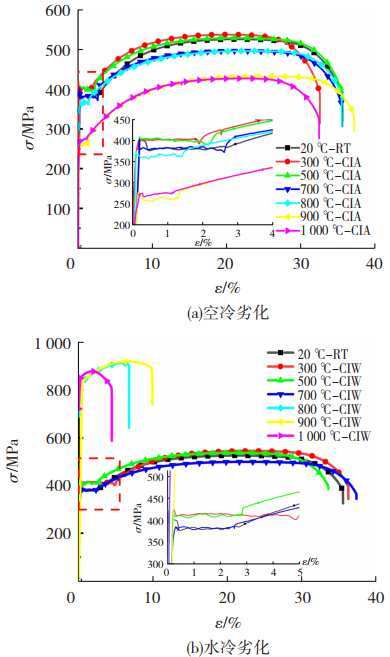
|
图 6 不同劣化处理下Q345B钢的应力-应变曲线 Fig.6 Stress-strain curves of Q345B steel under different deterioration treatments: (a)air cooling deterioration; (b) water cooling deterioration |
从图 6可知,Q345B钢的应力应变曲线及屈服平台特征受劣化温度、劣化冷却方式的双重影响。随着劣化温度的不断升高,空冷劣化后试样的抗拉强度先增后减,是由于温度越高导致组织中的渗碳体不断溶解,900 ℃以上时组织逐渐趋于粗化,使材料强度降低[17]。而劣化温度在20~700 ℃时,水冷劣化后的试样的抗拉强度变化不大;当劣化温度达到800~1 000 ℃时,材料的抗拉强度显著增加,屈服平台消失,而变形能力则显著降低,这是由于随着温度的升高,奥氏体形成的数量不断增加,最终转变为马氏体相,导致材料的抗拉强度和屈服强度显著增强,而塑性降低,脆性增强[18]。
2.3 劣化后材料的弹性模量与强度结果分析对高温劣化后各组试样的弹性模量、抗拉强度和屈服强度进行统计(误差棒±5%),结果如图 7所示。由图 7可知:劣化处理对材料的弹性模量影响很小,而对材料的强度影响较为明显,尤其是当劣化温度较高时。当劣化温度不超过700 ℃时,随着劣化温度的增加,Q345B钢的抗拉强度、屈服强度均先增后减,但波动范围不大;当劣化温度达到800~1 000 ℃时,空冷劣化的强度进一步降低,而水冷劣化后材料的强度均显著增大;与母材相比,1 000 ℃时空气劣化和水冷劣化后材料的抗拉强度变化幅值分别为-18.71%,+100.96%,屈服强度则分别为-36.57%,+101.60%。
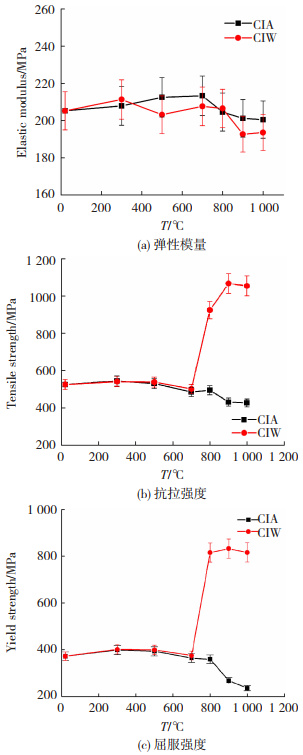
|
图 7 高温劣化后Q345B钢的弹性模量及强度统计结果 Fig.7 Statistical results of elastic modulus and strength of the Q345B steel after high temperature deterioration: (a) elastic modulus; (b) tensile strength; (c) yield strength |
图 8为各组劣化试样的宏、微观断口形貌,图 9为各组劣化试样的典型微观断口形貌。
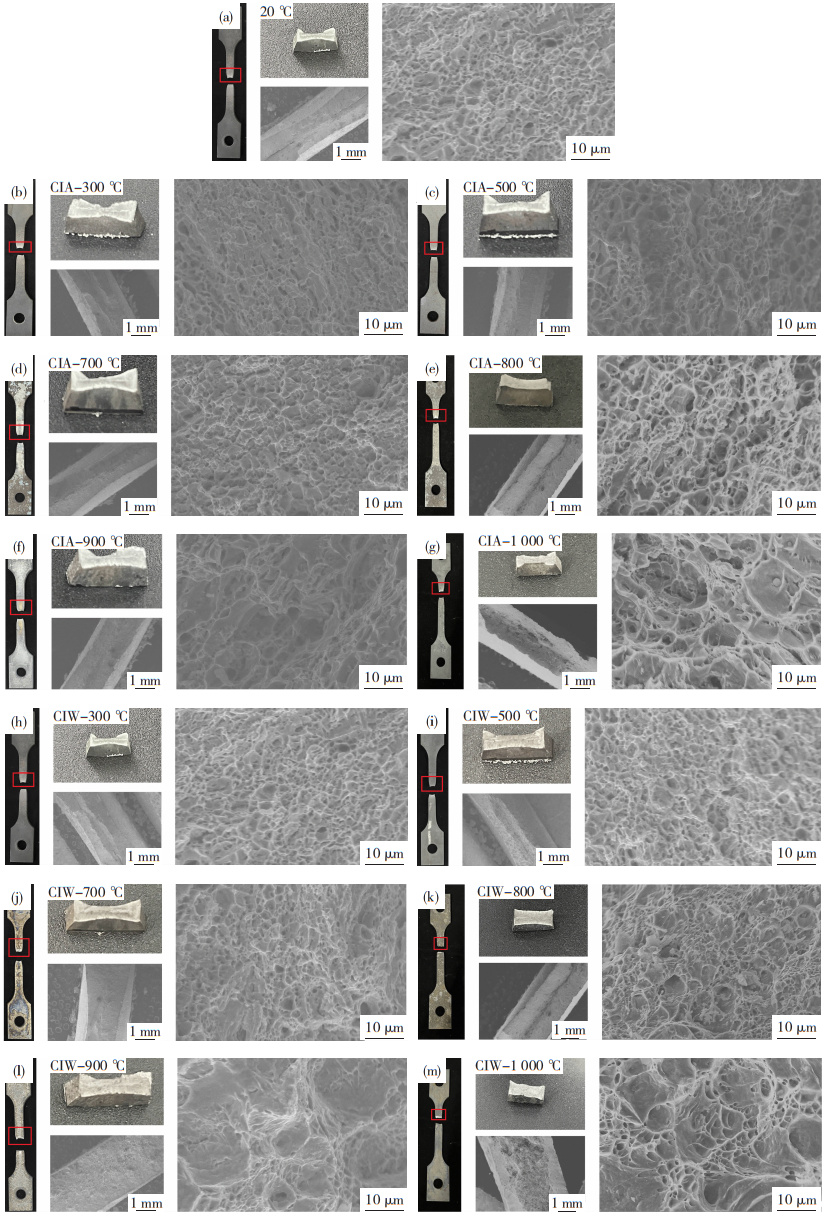
|
图 8 Q345B钢失效模式及宏观断口形貌 Fig.8 Failure mode and macroscopic fracture morphology of Q345B steel: (a) 20 ℃; (b) CIA-300 ℃; (c) CIA-500 ℃; (d) CIA-700 ℃; (e) CIA-800 ℃; (f) CIA-900 ℃; (g) CIA-1 000 ℃; (h) CIW-300 ℃; (i) CIW-500 ℃; (j) CIW-700 ℃; (k) CIW-800 ℃; (l) CIW-900 ℃; (m) CIW-1 000 ℃ |

|
图 9 劣化后Q345B钢的微观断口形貌 Fig.9 Micro-fracture morphology of Q345B steel after deterioration |
结合图 8和图 9可知,劣化后Q345B钢的断裂形式表现出韧性断裂和脆性断裂两种方式,前者的断口以韧窝(D)与微空洞(V)为主,而后者则具有河流状花样图案[19]和光滑平整的特征[20]。当劣化温度介于20~500 ℃时,断口以球状韧窝为主,韧窝深而小,断口呈现韧性断裂特征。当劣化温度增至700 ℃时,劣化后断口的韧窝尺寸变大,且水冷劣化后断口的变化更明显。劣化温度达到800 ℃时,空冷与水冷劣化后的断口差异显著,空冷劣化后断口的韧窝和微空洞显著增大,微空洞分布在韧窝四周;而对于水冷劣化后的断口(图 9(f)),韧窝尺寸增大,数量变少。当劣化温度超过900 ℃时,韧窝尺寸进一步增大,并出现了明显的撕裂棱(图 9(h)),断口呈现出韧脆混合断口特征。由此可知,随着水冷劣化温度的升高,材料变脆,这是由于水冷劣化后组织中出现的马氏体组织造成的[21]。
3 讨论 3.1 劣化方式对Q345B钢性能的影响为了揭示空冷[13-14]、水冷[13, 22-23]、消防泡沫冷却(Cooling in foam,CIF)[22-23]等劣化方式对材料性能的影响,分别采用劣化前后的弹性模量之比(弹性模量的变化因子ET/E)和强度之比(抗拉强度的变化因子σu, T/σu与屈服强度的变化因子σy, T/σy)描述劣化方式对材料的性能的影响规律,Q345钢(包括性能相近的Q355钢)劣化后的统计结果如图 10所示。
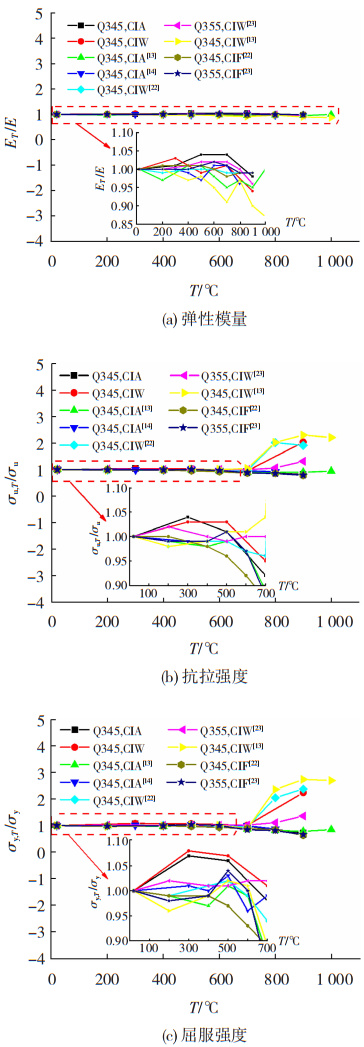
|
图 10 不同劣化方式下材料性能统计结果 Fig.10 Statistical results of material properties under different degradation modes: (a) elastic modulus; (b) tensile strength; (c) yield strength |
由图 10可以看出,弹性模量变化因子在1.0±0.05的范围内小幅波动,表明劣化温度和劣化冷却方式对材料弹性模量影响很小。当劣化温度低于700 ℃时,劣化冷却方式对强度变化因子的影响很小,强度变化因子随劣化温度的升高先升再降,但变化幅度小。当劣化温度超过700 ℃后,水冷劣化后材料强度变化因子大幅提升,提升2倍以上;而空冷和消防泡沫冷的强度变化因子进一步降低。
3.2 劣化温度与强度变化因子关系为了揭示劣化温度与材料强度变化因子之间的内在关系,采用非线性拟合及分段函数拟合的方法,分别对空冷和水冷劣化条件下的抗拉强度变化因子和屈服强度变化因子进行拟合,拟合结果如图 11、公式(1)~(4)所示。
| $ \begin{aligned} & \frac{\sigma_{\mathrm{u}, T}}{\sigma_{\mathrm{u}}}= \\ & \left\{\begin{array}{l} 1.02-5.85 \times 10^{-5} T \\ \quad\left(20^{\circ} \mathrm{C} \leqslant T \leqslant 700{ }^{\circ} \mathrm{C}\right) \\ -16\;499.01 \mathrm{e} \frac{-T}{72.89}+2.06, R^2=0.98 \\ \quad\left(700^{\circ} \mathrm{C} \leqslant T \leqslant 1\;000^{\circ} \mathrm{C}\right) \end{array}\right. \text { (CIW) } \end{aligned} $ | (1) |
| $ \begin{aligned} & \frac{\sigma_{\text{y}, T}}{\sigma_\text{y}}= \\ & \left\{\begin{aligned} & 1.03+2.05 \times 10^{-5} T \\ &\left(20^{\circ} \mathrm{C} \leqslant T \leqslant 700^{\circ} \mathrm{C}\right) \\ &-4.48 \times 10^9 \mathrm{e} \frac{-T}{31.68}, R^2=0.97 \\ &\left(700^{\circ} \mathrm{C} \leqslant T \leqslant 1\;000^{\circ} \mathrm{C}\right) \end{aligned}\right.\text { (CIW) } \end{aligned} $ | (2) |
| $ \frac{\sigma_{\mathrm{u}, T}}{\sigma_{\mathrm{u}}}=-0.009\;3 \frac{T}{306.03}+1.04, R^2=0.836(\text { CIA }) $ | (3) |
| $ \frac{\sigma_{y, T}}{\sigma_y}=-0.001\;4 \mathrm{e} \frac{T}{172.97}+1.06, R^2=0.87(\text { CIA }) $ | (4) |
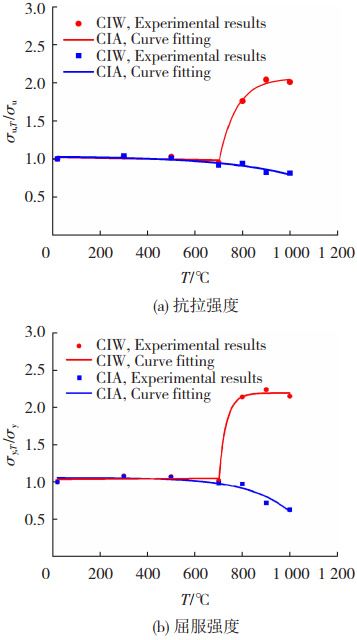
|
图 11 Q345B钢强度变化因子的拟合结果 Fig.11 Fitting results of strength variation factors of Q345B steel: (a) tensile strength; (b) yield strength |
式中:σu, T/σu和σy, T/σy分别为抗拉强度、屈服强度的变化因子; T为劣化温度; R2为决定系数,表示拟合精度。
因为R2不小于0.83,最大预测误差为4.88%,说明强度变化因子预测模型具有较高的预测精度。
4 结论1) 高温劣化处理对材料的强度影响程度与劣化温度和劣化冷却方式密切相关。当劣化温度低于700 ℃时,随着劣化温度的增加,Q345B钢的抗拉强度和屈服强度均先增后减,但波动范围不大;当劣化温度超过700 ℃后,材料强度随空冷劣化温度增大进一步降低,1 000 ℃时抗拉强度和屈服强度分别降低了-18.71%和-36.57%,这与空冷劣化后组织中的珠光体含量减小有关;材料强度随水冷劣化温度升高显著增大,1 000 ℃时抗拉强度和屈服强度分别提高了+100.96%和+101.60%,这是由于劣化后组织中的马氏体造成的。
2) Q345B钢的韧性受高温劣化方式影响,当劣化温度低于500 ℃时,劣化方式对材料的韧性影响不明显;随着劣化温度的升高,劣化方式对材料的韧性影响不断增强,水冷劣化使材料的韧性降低,脆性增加。
3) 揭示了Q345B钢的强度变化因子(σu, T/σu和σy, T/σy)与劣化温度(T)之间的关系,分别构建了空冷和水冷劣化后材料的强度变化因子预测模型,且模型的预测结果与实验值的偏差均在5%以内。
| [1] |
WANG W, LIU B, KODUR V. Effect of temperature on strength and elastic modulus of high-strength steel[J]. Journal of Materials in Civil Engineering, 2013, 25(2): 174-182. DOI:10.1061/(ASCE)MT.1943-5533.0000600 |
| [2] |
WANG W, LIU B, KODUR V. Temperature induced creep in low-alloy structural Q345 steel[J]. Journal of Materials in Civil Engineering, 2016, 28(6): 06016003. DOI:10.1061/(asce)mt.1943-5533.0001519 |
| [3] |
DU P, LIU H, XU X. Cyclic performance of structural steels after exposure to various heating-cooling treatments[J]. Metals, 2022, 12(7): 1146. DOI:10.3390/met12071146 |
| [4] |
郭庆, 王俊, 程磊, 等. Q345B钢氧化铁皮的高温粘附性研究[J]. 材料科学与工艺, 2023, 31(4): 34-40. GUO Qing, WANG Jun, CHENG Lei, et al. Study on high temperature adhesion of Q345B steel oxide scale[J]. Materials Science and Technology, 2023, 31(4): 34-40. DOI:10.11951/j.issn.1005-0299.20220319 |
| [5] |
JIANG J, BAO W, PENG Z Y, et al. Experimental investigation on mechanical behaviours of TMCP high strength steel[J]. Construction and Building Materials, 2019, 200: 664-680. DOI:10.1016/j.conbuildmat.2018.12.130 |
| [6] |
刘政, 魏金山, 崔冰, 等. 590MPa级高强钢双面双弧立焊焊缝组织性能[J]. 材料科学与工艺, 2016, 24(5): 34-40. LIU Zheng, WEI Jinshan, CUI Bing, et al. Microstructure and properties of double-sided double-arc vertical welding seam of 590 MPa high strength steel[J]. Materials Science and Technology, 2016, 24(5): 34-40. DOI:10.11951/j.issn.1005-0299.20160506 |
| [7] |
AZHARI F, HEIDARPOUR A, ZHAO X L, et al. Post-fire mechanical response of ultra-high strength (Grade 1 200) steel under high temperatures: Linking thermal stability and microstructure[J]. Thin-Walled Structures, 2017, 119: 114-125. DOI:10.1016/j.tws.2017.05.030 |
| [8] |
XUE X Y, SHI Y, ZHOU X H, et al. Experimental study on the properties of Q960 ultra-high-strength steel after fire exposure[J]. Structures, 2023, 47: 2081-2098. DOI:10.1016/j.istruc.2022.12.034 |
| [9] |
SINGH T G, SINGH K D. Post-fire mechanical properties of YSt-310 cold-formed steel tubular sections[J]. Journal of Constructional Steel Research, 2019, 153: 654-666. DOI:10.1016/j.jcsr.2018.11.014 |
| [10] |
REN C, DAI L, HUANG Y, et al. Experimental investigation of post-fire mechanical properties of Q235 cold-formed steel[J]. Thin-Walled Structures, 2020, 150: 106651. DOI:10.1016/j.tws.2020.106651 |
| [11] |
YAN X, XIA Y, BLUM H B, et al. Post-fire mechanical properties of advanced high-strength cold-formed steel alloys[J]. Thin-Walled Structures, 2021, 159: 107293. DOI:10.1016/j.tws.2020.107293 |
| [12] |
ZHOU X, XUE X, SHI Y, et al. Post-fire mechanical properties of Q620 high-strength steel with different cooling methods[J]. Journal of Constructional Steel Research, 2021, 180: 106608. DOI:10.1016/j.tws.2020.107293 |
| [13] |
SGI G, WANG S H, RONG C X. Experimental investigation into mechanical properties of Q345 steel after fire[J]. Journal of Constructional Steel Research, 2022, 199: 107582. DOI:10.1016/j.jcsr.2022.107582 |
| [14] |
DAN W J, GOU R B, YU M, et al. Experimental study on the post-fire mechanical behaviours of structural steels[J]. Journal of Constructional Steel Research, 2022, 199: 107629. DOI:10.1016/j.jcsr.2022.107629 |
| [15] |
靳淑静, 顾丽, 江姗, 等. 正火温度对N08367/Q345R复合板组织和性能的影响[J/OL]. 热加工工艺: 1-5[2024-07-01]. JIN Shujing, GU Li, JIANG Shan, et al. Effect of normal ignition temperature on the organization and performance of N08367/Q345R composite plates[J/OL]. Thermal processing process: 1-5[2024-07-01]. https://doi.org/10.14158/j.cnki.1001-3814.20211069. |
| [16] |
常耀东, 齐会萍, 贾燕龙, 等. Q345/40Cr钢双金属环件的热处理工艺及组织性能[J]. 金属热处理, 2023, 48(3): 195-202. CHANG Yaodong, QI Huiping, JIA Yanlong, et al. Q345/40 Heat treatment process and tissue properties of Cr steel bimetallic rings[J]. Heat treatment of metals, 2023, 48(3): 195-202. DOI:10.13251/j.issn.0254-6051.2023.03.032 |
| [17] |
WANG B A, WANG N, YANG Y J, et al. Fabrication, microstructures and mechanical properties of ZrO2 dispersion-strengthened Q345 steel[J]. Transactions of Nonferrous Metals Society of China, 2018, 28(6): 1132-1140. DOI:10.1016/s1003-6326(18)64750-8 |
| [18] |
陈庆. 淬火温度对马氏体/铁素体双相钢组织性能的影响[J]. 冶金分析, 2018, 38(10): 63-67. CHEN Qing. Effects of quenching temperature on the microstructure and properties of martensite/ferrite dual phase steel[J]. Metallurgical Analysis, 2018, 38(10): 63-67. DOI:10.13228/j.boyuan.issn1000-7571.010417 |
| [19] |
SAJID U H, KIRAN R. Influence of stress concentration and cooling methods on post-fire mechanical behavior of ASTM A36 steels[J]. Construction and Building Materials, 2018, 186: 920-945. DOI:10.1016/j.conbuildmat.2018.08.006 |
| [20] |
GANG S, SHI H W, XUE S C, et al. Post-fire mechanical properties of base metal and welds of Q235 steel[J]. Journal of Constructional Steel Research, 2021, 183: 107888. DOI:10.1016/j.jcsr.2023.107888 |
| [21] |
黄少波, 盛洁, 袁甜, 等. 热处理工艺对7Cr17MoV马氏体不锈钢组织性能的影响[J]. 热加工工艺, 2015, 44(24): 192-196. HUANG Shaobo, SHENG Jie, YUAN Tian, et al. Effect of heat treatment process on the tissue properties of 7Cr17MoV martensitic stainless steel[J]. Thermal Working Process, 2015, 44(24): 192-196. DOI:10.14158/j.cnki.1001-3814.2015.24.056 |
| [22] |
ZHANG C, JIA B, WANG J. Influence of artificial cooling methods on post-fire mechanical properties of Q355 structural steel[J]. Construction and Building Materials, 2020, 252(12): 119092. DOI:10.1016/j.conbuildmat.2020.119092 |
| [23] |
ZHANG C, WANG R, ZHU L. Mechanical properties of Q345 structural steel after artificial cooling from elevated temperatures[J]. Journal of Constructional Steel Research, 2021, 176(12): 106432. DOI:10.1016/j.jcsr.2020.106432 |
 2024, Vol. 32
2024, Vol. 32


